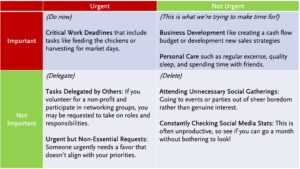A New Year’s Resolution to Do Less

The New Year offers a time of self-reflection and an opportunity for a fresh start; to do things better this year than the year before. I won’t suggest a “resolution” for the New Year, but rather a gentler approach: to be kinder to yourself.
Resolutions are full of “shoulds.” What you should do. And as I’ve written about before (and talk a lot about in the 2nd edition of The Farmer’s Office), “should” is judgmental and shaming.
If I were to offer a kinder resolution for the New Year it would be this: do less.
I would further proffer – doing less can improve your business and well-being.
Too often, our instincts guide us to do more if we want to grow our business. But let’s be clear, the goal isn’t “grow the business”, the goal is to increase profits so that you can increase your quality of life, as well as that of your community. And improved profits and quality of life can often be achieved by doing less.
Cut back on a sales channel. Reduce your product offerings. Limit the acres in production.
When you cut back, you can focus on the most profitable and most rewarding activities. And you can free up time to improve the parts of your business you do choose to hold onto.
Let me give you an example:
I worked with a farmer who was feeling stressed by the business and just couldn’t get ahead of anything. With a farm store that was open 7 days a week, he rarely was able to take a full day off (even though he had the staff, there was always an “emergency” that required his attention).
The “value” of trying to capture every. single. customer. on every. single. schedule. was making the business untenable. He decided to cut back the hours of operation. By freeing up hours each week, he had the head space to think about marketing strategies which would help ensure the same volume of customers came to the store each week even with the reduced hours.
Sometimes doing less can give you permission to let go of what’s not working. I was talking with a farmer about the challenges of the last growing season; they struggled with their red peppers. When they didn’t size out adequately, they ended up buying in from another farm. Not only did they have the added expense of buying in peppers, but they also had the sunk costs of all the supplies and labor of the peppers they did plant. Had they just bought in peppers from the beginning, they would have had more profits and more time. What can you let go of?
How can doing less improve your bottom line?
Let’s say you sell your farm goods at a farmers market and through an online store – you have two sales channels to manage: two marketing plans (with two different customer bases), two distribution models; two inventory management systems.
If you cut out one of your sales channels (let’s say, the farmers market), you can develop strategies to increase sales through your online store. You have time to build your social media presence and drive customers to your website. You can focus on distribution to increase your reach; and increase efficiencies.
When you sell through multiple channels, there just isn’t the bandwidth to go deep into business development for all channels.
There will always be some aspects of your business that are more profitable and efficient than others. I’m not sure I believe the 80/20 rule to the letter (that is, 80% of your business comes from 20% of your customers) but a variation of that is true. Figure out what your “80/20” is… focus your business there, and cut out the extra.
Perhaps this sounds a little too “pie in the sky” for you. Let me offer you a few practical strategies to help you figure out what to cut out.
1. Check out the opportunity cost webinar. I walk through the process of calculating your profit per hour… that is, for every hour of selling through different sales channels, how much profit do you earn? Which of your sales channels is most profitable? Which ones can you let go of?
2. Check out the channel analysis lesson in reading financial statements course. In that video I walk through the process, step by step of how to figure out which of your product lines are most profitable.
When you know what’s most profitable, you can cut out what’s not. You may even discover that some of your product lines lose money… and if you cut them out – you’ll free up time and increase profits (just like the farmer who struggled with red peppers). Win/win. How comforting would it be to know you don’t have products that drag down the business.
3. And finally, consider what you do in the day that doesn’t move your business forward and bring you fulfillment. One easy exercise is to fill out the “Urgent/Important” matrix. Take an inventory of all the things you do each day (from the mundane of folding laundry to the important feeding chickens; as well as everything in between from running errands, scrolling on social media, chatting with friends, or managing drama between your farm employees.) Now, consider what is important and what is urgent. Things like feeding chickens and watering the greenhouse are urgent (they must be done when they need to be done) and important. Other things are urgent but not important (like responding to all the notifications on your phone – and they can feel urgent if your phone is constantly buzzing and beeping). As you look at your list, focus on the “not important” column. Things in the “not important/not urgent column” can be ditched right away. Things that are “urgent/not important” are distractions that can be delegated.

Here’s a list of examples that I found helpful to get ideas of what’s in your life that fit into each quadrant.
Working through a list of how you spend your time can also help you think about the distractions from your day and what is getting in the way of your long-term goals.
In summary:
Doing less means more time to focus on what’s important… the most profitable/enjoyable aspects of your business and life, including on self-care. You need to be able to sustain yourself in good health to maintain your business. And that means working at a pace that allows time for rest and doing less.
